Estimated reading time: 9 minutes
We’ve always grown a selection of plants under our fruit trees.
Sure, you’d probably think of most of them as “weeds” but as far as nature is concerned, that doesn’t matter at all.
We always start the conversation about how to manage the space under your fruit tree with the basic principles:
- Bare earth is the worst.
- Mulch is second-best (and some mulches are better than others).
- Best of all is a diverse mix of live plants.
But we understand it’s a journey. Lots of the gardeners we’ve worked with want to get rid of the weeds under their trees but aren’t sure what to replace them with.
As Dr Christine Jones explained in detail in this masterclass, growing live plants under your trees is healthier for the soil, the microbes, and your fruit trees. Ultimately, it’s also better for your health and the planet!
However, many people get stuck on which plants to grow under their fruit trees, which is why we created this guide to edible flowering plants. And we’re always on the lookout for examples of diverse understory plantings.
Companion planting around fruit trees
A visit to Perth led to us stumbling on these incredibly diverse garden beds. They make up the Urban Orchard, a delightful outdoor space created on top of a carpark.
We talk about diverse understory plantings all the time. But this is the first time we’ve found a public garden dedicated to showing people what to grow under their fruit trees.
It’s not often that you get to see so many different combinations being tested.
What exactly is a fruit tree guild?
A fruit tree guild is a permaculture term. Basically, it’s a fancy name for a bed of mixed plantings that also features a tree. Usually, guilds are planted around fruit trees.
The beds at the Perth Cultural Centre fit the bill exactly. So, with thanks to the foresighted people who set up this beautiful garden, we’ll share some of the plant groupings here.
Some of the trees weren’t looking super healthy, and not all of the understory plants that had been planted had survived.
But the amount of thought and planning that has gone into this garden makes our hearts sing. Most of the plants included in the groupings are edible. And most of the ones that aren’t edible have medicinal value.
In no particular order, here is a selection of the beds. We hope you find them as inspirational as we do.
Bed 10: Nectarine and white shatoot mulberry trees
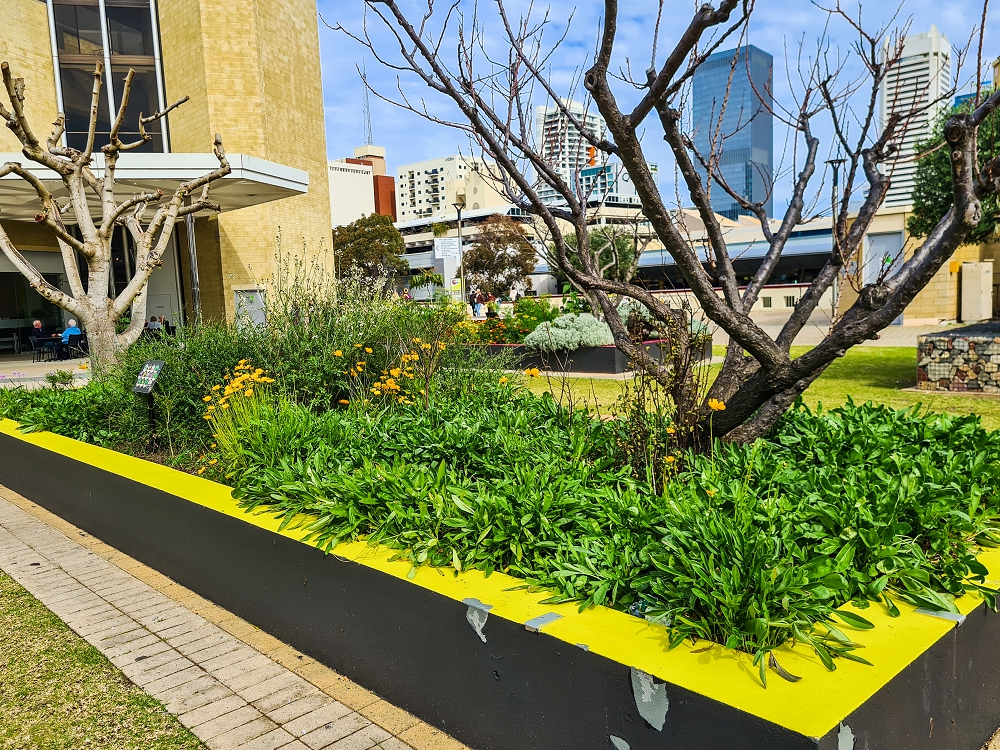
Plants growing under the trees:
- Corn (Zea mays). Corn has high levels of antioxidant that increase when you cook it. It’s also high in niacin, potassium, magnesium, and essential fatty acids.
- Winter savoury (Satureja montana). This medicinal plant is a carminative (which means it helps to reduce farting!) and digestive aid. Also antiseptic and astringent. Can be used to relive insect bites.
- Purple basil (Ocimum basilicum). The purple variety of basil can be used in the same way as the more common green basil. Contains heaps of vitamins and minerals, and is packed with vitamin K.
- Tansy (Tanacetum vulgare). A medicinal plant, tansy has been used to treat painful joint conditions like arthritis and rheumatism. Can also be used to treat migraines, headaches, sciatica, nerve pain, ulcers, intestinal worms and parasites and to encourage regular menstruation.
- Snapdragons (Antirrhinum majus)
- Mallow (Malva). An anti-inflammatory herb, can be used to heal digestive and urinary tract infections. Also used for coughs and insect bites. High in calcium, magnesium, potassium, iron, selenium, and Vit A & C. Leaves can be eaten like spinach cooked or raw.
- Mint (Mentha). Fabulously useful culinary herb.
- Zucchini (Cucubita pepo)
- Finger lime (Citrus australasica). Rich in folate, potassium, and Vitamin E. Finger limes have more Vit C than other citrus.
- Ruby saltbush (Enchylaena tomentosa). The leaves and fruits of the Ruby Saltbush are both edible, however excessive quantities can make rheumatism, arthritis, gout, or kidney stones worse.
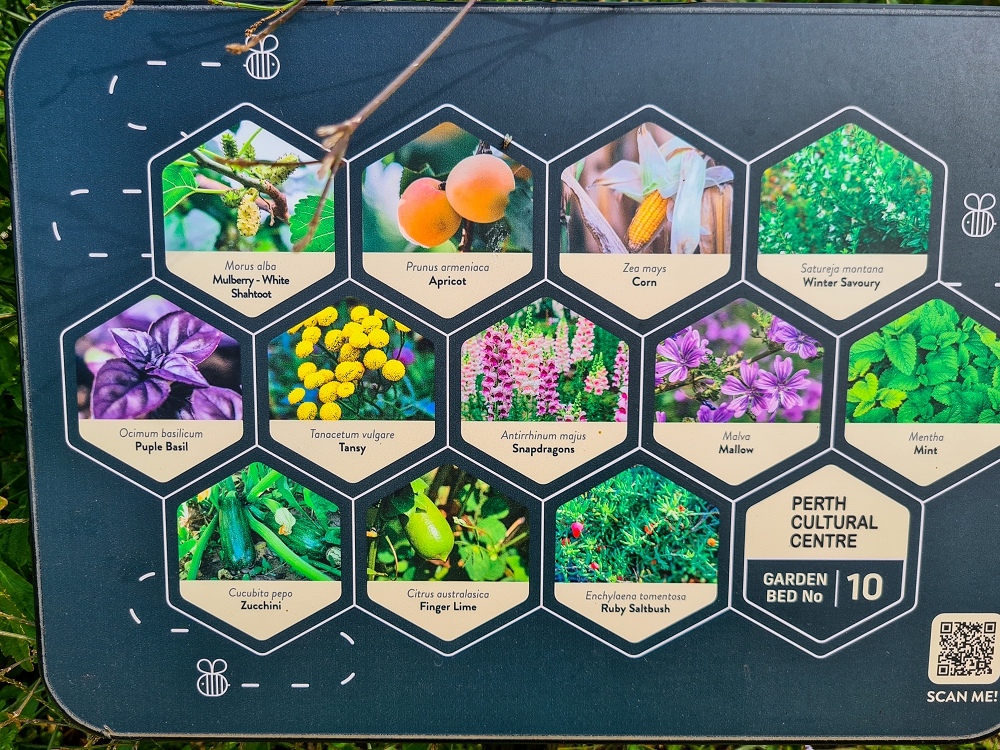
Bed 11: Peach tree
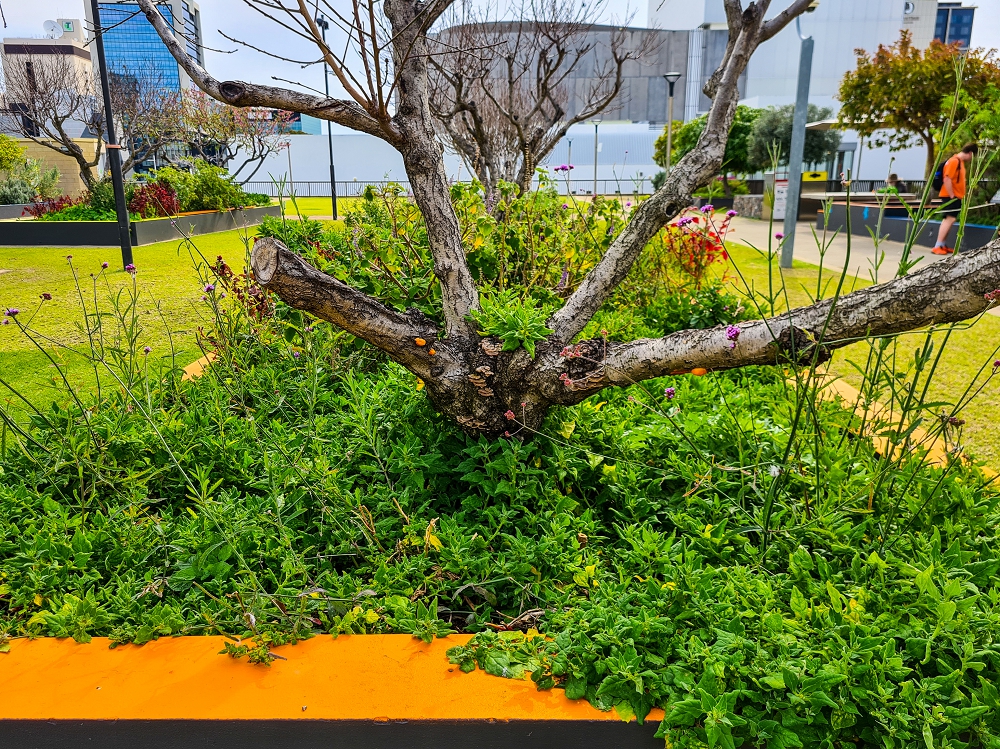
Plants growing under the tree:
- Thai basil (Ocimum basilicum var. thyrsiflora). Contains high levels of Vit C and omega-3 fatty acids. Seeds contain high levels of antioxidant and are said to be useful in combating cancer, viruses, bacteria, and fungi.
- Rocket (Eruca sativa). A good source of Vit A, lutein, and zeaxanthin – all good for eyes. Also has calcium, potassium, Vit C, folate, and Vit K.
- Marigolds (Tagetes erecta). These beautiful flowers help to deter pests like nematodes, and are used in skin lotions and balms. Great for attracting good bugs.
- Amaranth (Amaranthus). Has high levels of antioxidants, proteins, minerals, and vitamins. Related to quinoa.
- Purslane (Portulaca aleracea). An amazing plant that often springs up as a weed in summer. High in Vit A, B, and C, and very high levels of omega-3 fatty acids.
- Warrigal greens (Tetragonia tetragonioides). Native spinach with a similar flavour to spinach. Rich in Vit C and antioxidants, however contain high levels of oxalic acid so the leaves must be blanched before cooking.
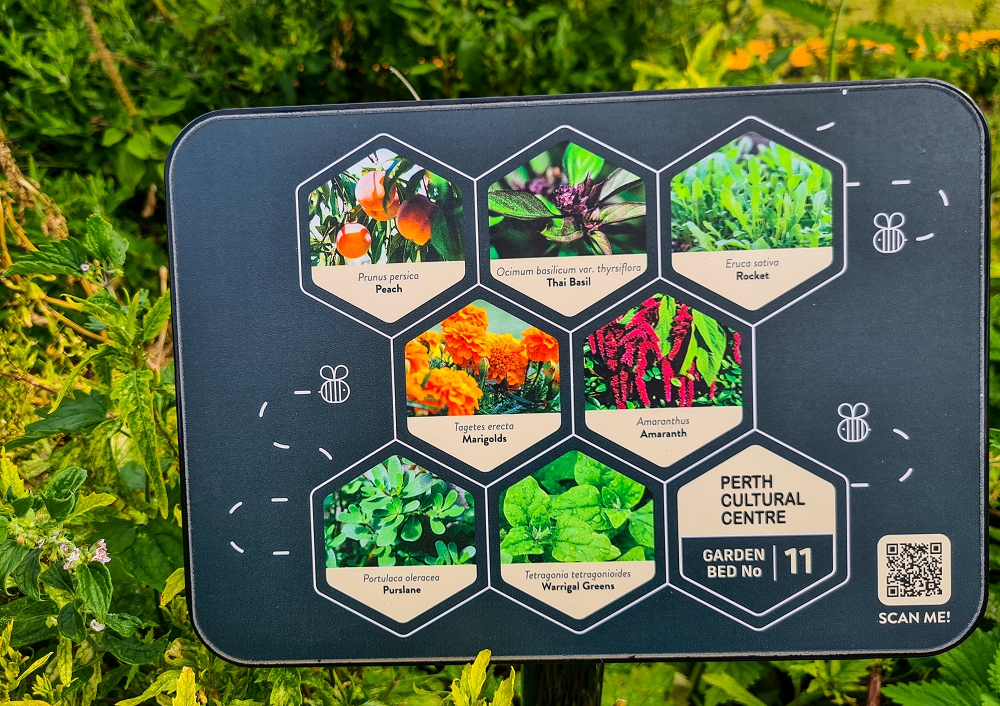
Bed 16: Mandarine and lime trees

Understory plants:
- Purple vervain (Verbena bonariensis). Anti-microbial.
- French lavender (Lavandula stoechas). Lavender oil is antiseptic and anti-inflammatory. Lavender is one of the most useful herbs to grow under your fruit trees as it’s good for everything from headaches to insect bites.
- Wormwood (Artemis absinthinium). Wormwood is best known as a preventive of mites and parasites in chickens, and also has many medicinal uses for people.
- Salvia Hotlips (Salvia microphylla). High in antioxidants and contains a lot of anti-inflammatory compounds. Also antibacterial and wound-healing.
- Lemon balm (Melissa officinalis). Known to help reduce stress and anxiety, make it easier to sleep, and treat cold sores.
- Indian Ginseng (Withania somnifera). Well known as a medicinal plant, ginseng has been used for anxiety, stress, pain, fatigue, diabetes, arthritis, and epilepsy. Can lower blood pressure and high cholesterol.
- Yarrow (Achillea millefolium). A useful plant for healing wounds, plus can be useful for digestive disorders. Also know for treating anxiety and depression.
- Comfrey (Symphytum). A fabulous plant to grow under your fruit trees because bees love it. It also has many medicinal uses such as anti-inflammatory.
- Society garlic (Tulbaghia violacea). Can be used in cooking similar to ordinary garlic.
- Lemongrass (Cymbopogon citratus). Contains antioxidants and anti-inflammatories.
- Salt bush (Atriplex nummularia)
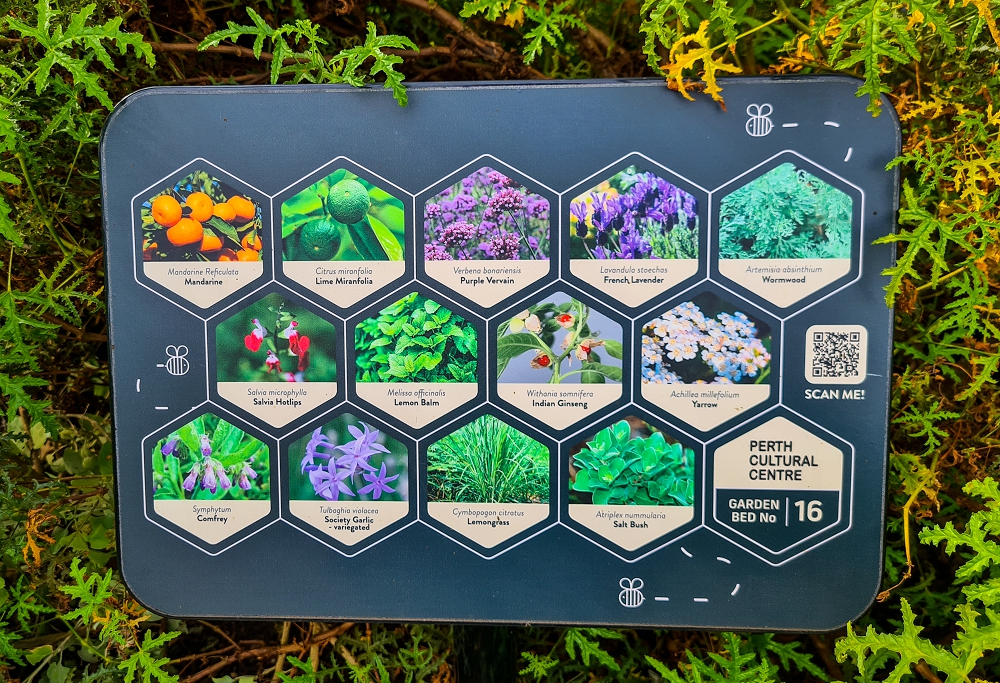
Garden Bed 17: Orange tree
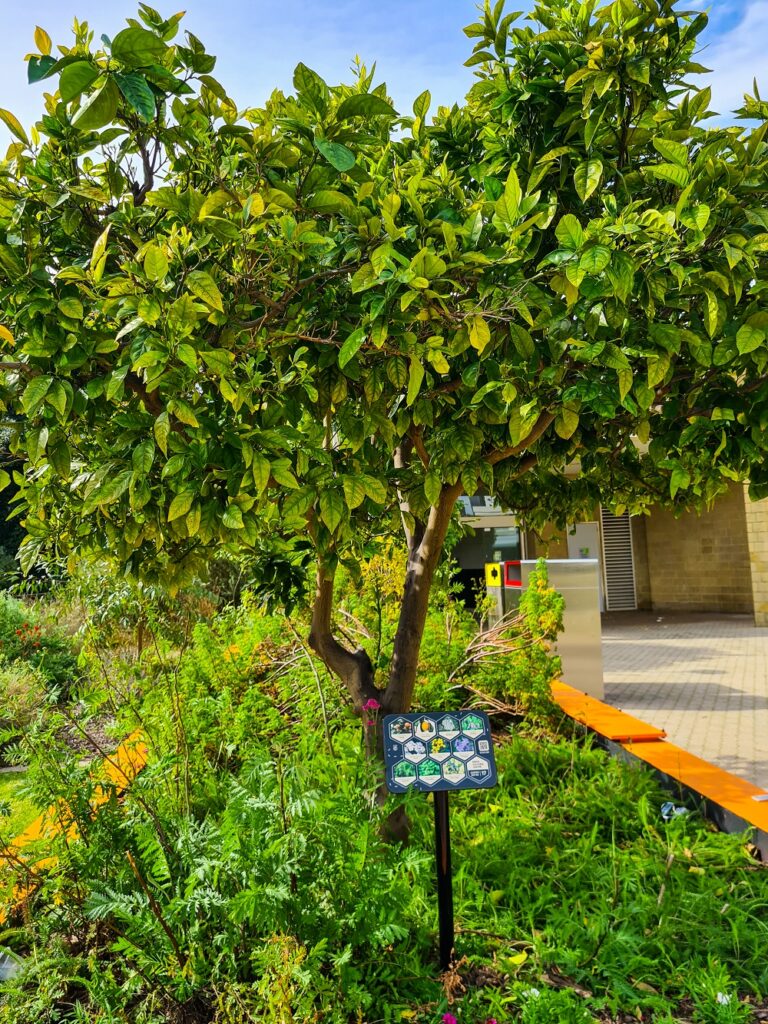
Understory plants:
- Elderflower (Sambucus). Berries and flowers contain high levels of antioxidants and vitamins that can help with immune function. Used to treat inflammation, stress, gut problems, headaches, fever, kidney problems, and HIV/AIDS.
- Comfrey (Symphytum)
- Yarrow (Achillea millefolium). A useful plant for healing wounds, plus can be useful for stomach problems and anxiety.
- Tansy (Tanacetum vulgare)
- Society garlic (Tulbaghia violacea)
- Marjoram (Origanum majorana). Mainly known as a culinary herb. Marjoram can also be used to treat digestion and menstruation problems.
- Lemon balm (Melissa officinalis)
- Maroon bush (Scoevola spinascens). Also called Murin, this native plant has been used in traditional medicine for colds and stomach issues.
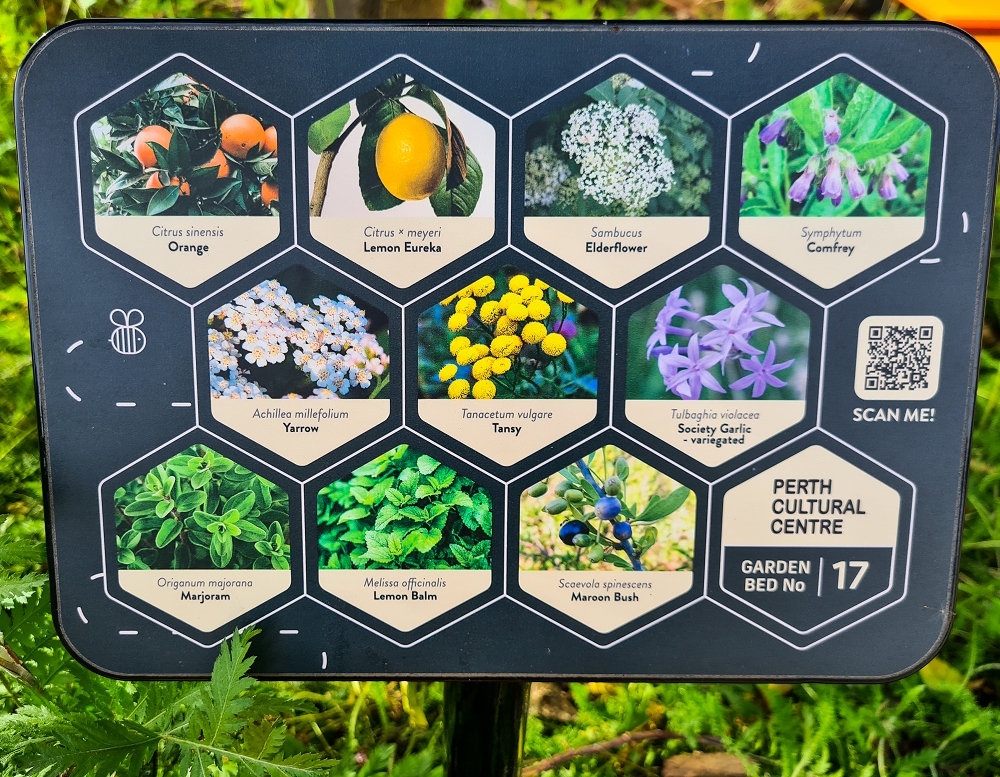
Number 18: Olive tree (Manzanillo)
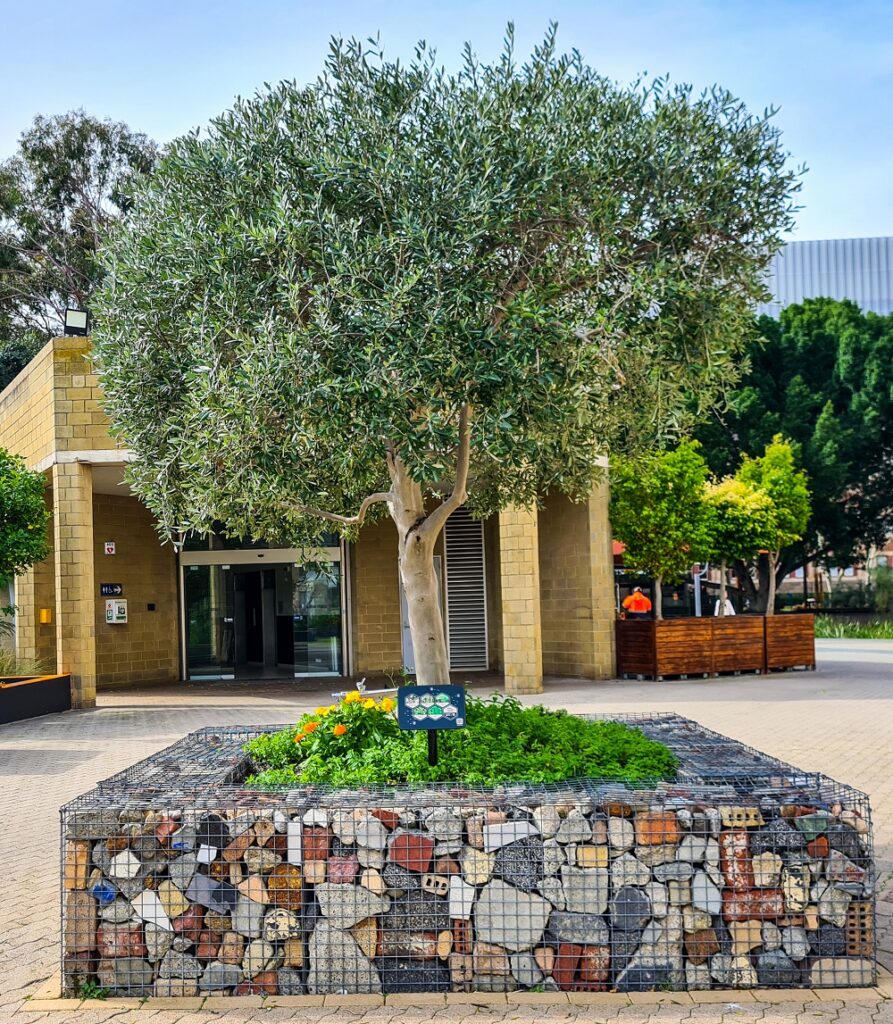
Understory plants:
- Prostrate rosemary (Rosmarinus officinalis Prostatus)
- Chives (Allium schoenoprasum). Contain Vit K, C, and A. Potentially useful for treating cancer, sleep disorders, and inflammation.
- Oregano (Origanum vulgare)
- Mint (Mentha)
- It looks like there’s some calendula in there as well, even though it’s not on the board

Hopefully that is making your brain ping with new ideas about what to plant under your fruit trees.
The Urban Orchard was big, varied, and quite complex. Too much for one blog, so we’ll bring you the rest of the beds in another blog.
Related Articles
Do your fruit trees have the right pollination partners?
Estimated reading time: 6 minutes Pollination partners for fruit trees are one of those things that most gardeners have heard of, but few really…
Is organic growing really any better?
Long-term studies have shown that organic growing is better for your health and the planet, and it may even be better for your pocket.
Animals, fruit trees, and electric fences
Animals and fruit trees go well together if you can figure out how to enjoy the benefits without the animals doing too much damage.

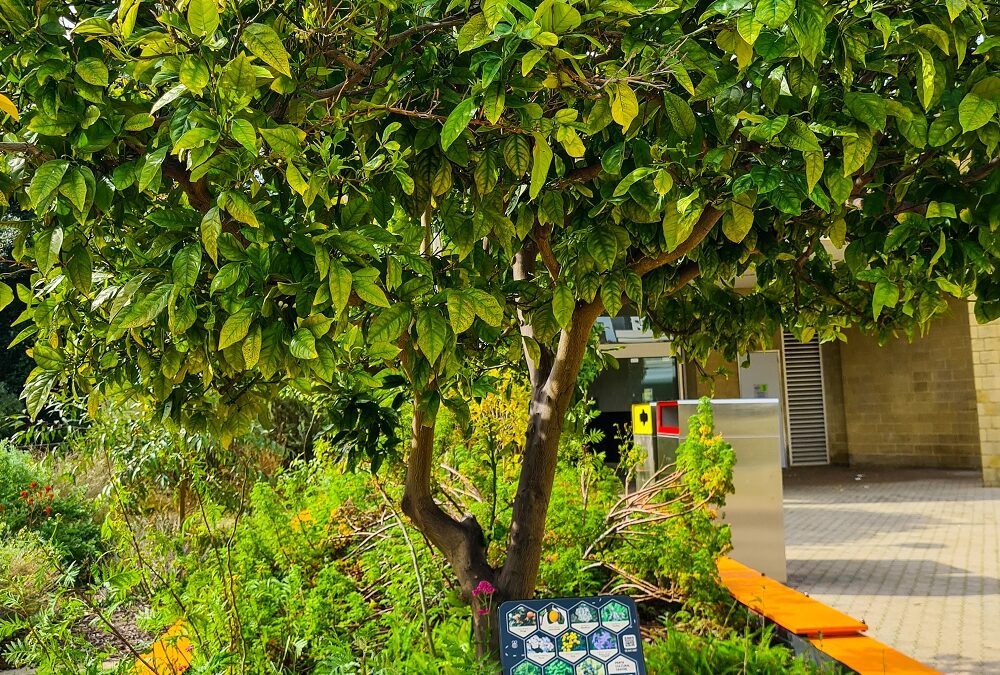



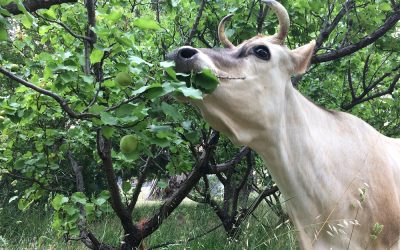


How does growing an edible understorey work with maintaining a coverspray on fruit trees? I used to grow herbs under my fruit trees, but I feel likecthey must be dripping with wettable sulphur and I don’t think this would be good to eat.
This is a great question Sarah and a good point. One way around it might be to grow things that you plan to harvest well after spraying? Or, grow beneficial ornamentals for colour & life in the garden! I understand that wettable sulfur is oftened used on vegetable crops as well so could be worth looking into how vegie growers might manage any risks from that. Meg – GGF team.
Hi Guys,
Thanks for the post on the Perth Cultural Centre and what to plant under fruit trees. Their solution for planting the olive tree is fantastic and is exactly what I need for our new turn around driveway – needed a rock breaker in certain areas to create. In response to you comment “But the amount of thought and planning that has gone into this garden makes our hearts sing. Most of the plants included in the groupings are edible. And most of the ones that aren’t edible have medicinal value.” It comes as no surprise to know that Josh Byrne Associates was involved in the Planning for this project instigated by The Metropolitan Redevelopment Authority. https://www.afr.com/companies/the-city-feeding-the-city-urban-orchard-bears-fruit-20150528-ghbnpd
Did you also see Perth City Farm? https://perthcityfarm.org.au/gardening/farm/
Hi Veronica, thanks for this detail – it’s great to know (and unsurprising) that Josh was involved. Thanks for the links also, it’s good to learn more about this beautiful project.
Thanks for sharing Veronica! That makes a lot of sense! We’ll check out Perth City Farm, looks great. Meg – GGF team.
Can anyone tell me if it is possible to plant a peach tree in a flowerbed 6 feet away from edible Artemis herb plant
I read that citrus trees have shallow roots and so I’m wondering if I’m digging around my orange tree to plant the companion plants, will it adversely affect the tree?
How do I feed a tangerine tree to yield sweet fruit? Current yield is substantial but sour and smells fishy